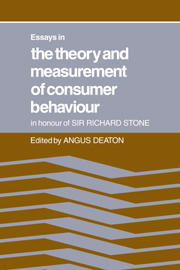Book contents
- Frontmatter
- Contents
- Foreword
- List of contributors
- Part one The analysis of commodity demands
- Introduction
- 1 Some Engel curves
- 2 Suggestions towards freeing systems of demand functions from a strait-jacket
- 3 Theoretical and empirical approaches to consumer demand under rationing
- 4 The independence transformation: a review and some further explorations
- 5 The analysis of consumption and demand in the USSR
- Part two The theory of index numbers
- Part three The consumption function and durable goods
- Part four Other aspects: fertility and labour supply
- Bibliography of Sir Richard Stone's works 1936–79
- Index of names
- Subject index
3 - Theoretical and empirical approaches to consumer demand under rationing
Published online by Cambridge University Press: 05 November 2011
- Frontmatter
- Contents
- Foreword
- List of contributors
- Part one The analysis of commodity demands
- Introduction
- 1 Some Engel curves
- 2 Suggestions towards freeing systems of demand functions from a strait-jacket
- 3 Theoretical and empirical approaches to consumer demand under rationing
- 4 The independence transformation: a review and some further explorations
- 5 The analysis of consumption and demand in the USSR
- Part two The theory of index numbers
- Part three The consumption function and durable goods
- Part four Other aspects: fertility and labour supply
- Bibliography of Sir Richard Stone's works 1936–79
- Index of names
- Subject index
Summary
It is a matter of common observation that the quantities consumed of many goods and services are not directly under the control of those who consume them. The level of provision of public goods cannot be varied to taste by any single consumer: shortages or formal rationing of market goods may place an upper limit on consumption: transactions costs or market imperfections, particularly in asset markets, may prevent the short-run adjustment of stocks to their optimum levels so that consumers may have to consume too much as well as too little. Perhaps most importantly, involuntary unemployment in the labour market can be thought of as an enforced consumption of an undesirably large amount of leisure. All these situations involve quantity constraints on consumer behaviour, and although rationing is only one possibility, we shall use the term to deal with all, including those situations where more is consumed than would be freely bought.
As one might expect, much of the early work on rationing was done during and immediately after the second world war. This work is surveyed in the classic paper by Tobin (1952). For a considerable period subsequently, there appeared to be little interest in the subject and little was published, although see the two papers by Pollak (1969; 1971). In the last few years, however, rationing has once again become a major focus of attention.
- Type
- Chapter
- Information
- Essays in the Theory and Measurement of Consumer Behaviour: In Honour of Sir Richard Stone , pp. 55 - 72Publisher: Cambridge University PressPrint publication year: 1981
- 13
- Cited by



